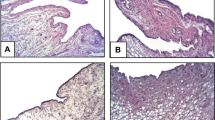Summary
Porcine articular cartilage from cases of experimentally induced Erysipelas polyarthritis, a comparative model of rheumatoid arthritis (RA) in man, was examined with different histological and immunohistochemical techniques. The preexisting canals in articular cartilage played a crucial role during the flooding and deposition of arthritogenic microorganisms deep into the cartilage matrix. Subsequently this vascularized tissue mediated the same inflammatory reactions in hyaline cartilage of young animals as seen in other connective tissues. However, these stereotypical responses to injury were modulated by the unique composition and structure of articular cartilage.
Similar content being viewed by others
References
Stockwell RA (1979) Biology of cartilage cells. Cambridge University Press, Cambridge London New York
Carlson CS, Hilley HD, Henrikson CK (1985) Ultrastructure of normal epiphyseal cartilage of the articular-epiphyseal cartilage complex in growing swine. Am J Vet Res 46:306–313
Bhatnagar R, Christian RG, Nakano T, Aherne FX, Thompson JR (1981) Age-related changes and osteochondrosis in swine articular and epiphyseal cartilage: light and electron microscopy. Can J Comp Med 45:188–195
Denecke R, Kaup FJ, Meyer M (1985) Intercellular network in articular cartilage of pigs with experimentally induced arthritis. I. Fact or artifact? Rheumatol Int 5:265–271
Kincaid SA, Allhands RV, Pijanowski GJ (1985) Chondrolysis associated with cartilage canals of the epiphyseal cartilage of the distal humerus of growing pigs. Am J Vet Res 46:726–732
Deicher H, Schulz LC (1981) Arthritis. Models and mechanisms. Springer, Berlin Heidelberg New York
Pearson CM (1979) Arthritis in animals. In: McCarty DJ (ed) Arthritis and allied conditions. Lea and Febiger, Philadelphia, pp 308–318
Schulz LC (1980) Zwei-Phasenkonzept der Rheumatoiden Entzündung. Pathomechanismen am Modell der Rotlauf-Polyarthritis der Ratte. Enke, Stuttgart
Ugai K, Ishikawa H, Hirohata K, Shirane H (1983) Interactions of polymorphonuclear leukocytes with immune complexes trapped in rheumatoid articular cartilage. Arthritis Rheum 26:1434–1441
Pritchard MH (1984) Synovial protease/inhibitor ratios in erosive and nonerosive arthropathies. Ann Rheum Dis 43:50–55
Dingle JT, Saklatvala J, Hembry R, Tyler J, Fell HB, Jubb R (1979) A cartilage catabolic factor from synovium. Biochem J 184:177–180
Ziff M (1983) Factors involved in cartilage injury. J Rheumatol (Suppl 11) 10:13–25
Jubb RW (1982) Breakdown of articular cartilage by vascular tissue. J Pathol 136:333–343
Denecke R, Trautwein G (1986) Lokale Antigenpersistenz und Chronizität der experimentellen Rotlauf-Polyarthritis. Berl Münch Tierärztl Wochenschr 99:200–208
Author information
Authors and Affiliations
Rights and permissions
About this article
Cite this article
Denecke, R., Trautwein, G. & Kaup, F.J. The role of cartilage canals in the pathogenesis of experimentally induced polyarthritis. Rheumatol Int 6, 239–243 (1986). https://doi.org/10.1007/BF00541313
Received:
Accepted:
Issue Date:
DOI: https://doi.org/10.1007/BF00541313




